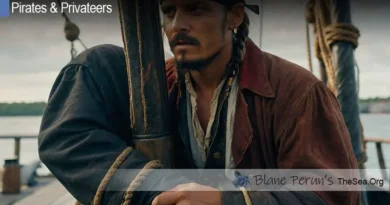Bartholomew Roberts
If the number of vessels taken is any measure of a pirate’s success during the golden age of sail, Bartholomew Roberts tops the list. This Welshman, born in 1682, took more than 400 ships during his three years as a pirate off the coast of the Americas and West Africa. He is known to have first began sailing at the age of 13, but a further appearance in the historical records of the time did not occur until 1718, at the age of 36.
While working on a slave ship under Captain Abraham Plumb off the coast of present-day Ghana, Bartholomew Roberts was captured by pirates and forced to work for his new employers. The pirate captain Howell Davis, also a Welshman, took to consulting Roberts for his capabilities as a navigator, as well as confiding in him in their native Welsh language, which allowed important information to be passed secretly without the predominantly English-speaking sailors interception. During an attempted kidnapping on the island of Principe, Captain Howell was shot dead and a new pirate captain had to be elected for the ship once they had escaped.
Now endowed with his own ship and crew, Bartholomew Roberts went back to Principe to avenge his captain’s death. After ambushing the city and plundering it for its valuables, the new captain waited off the coast of Brazil for nine weeks before happening across a Portugese merchant fleet of 42 ships awaiting armed escort. Roberts seized the opportunity and began his lucrative career as pirate captain for the next three years in which he amassed a fortune that would surpass $35 million equated in modern financial terms.
During his tenure as famous pirate captain, Bartholomew Roberts adhered to 11 popular rules by which he managed his pirate enterprise. This came to be known as the pirate’s code, and became widely adopted by the pirate captains who came after him. His good fortune came to an abrupt halt when faced with a clever feint by the HMS Swallow in 1722. The pirates believed they were taking another merchant ship, but the Swallow was in fact a military vessel that scattered Robert’s fleet and took down his ships in the ensuing battle. Robert was killed by grapeshot and his body thrown overboard as per his wishes before the battle ended.
The Rise of a Pirate King
Have you ever wondered how an ordinary sailor becomes a notorious pirate? For Bartholomew Roberts, it was not a matter of choice, but of fate. Captured by pirates, he was forced to join their ranks. But, as if the sea whispered to him, he rose swiftly through the ranks, proving that sometimes, a person can find their true calling in the most unexpected places. Roberts transformed into one of the most feared pirates of his time, his exploits becoming the stuff of legend. His adventures not only captivated those at sea but also left an indelible mark on the history of piracy in literature, inspiring countless tales and characters that followed. As he sailed the unpredictable waves, he proved that destiny often charts a course of its own, steering even the most unlikely individuals toward greatness.
The Code of the Pirate Council
Like any leader, Roberts knew the value of rules. Under his command, pirates followed a strict code. Think of it as the HR policy of the high seas – a set of guidelines that kept the crew in line, ensuring even the most unruly pirates played by the book.
The Sea as a Stage
For Roberts, the ocean was more than just a body of water; it was a grand stage where he performed his most daring acts. Each conquest was a scene, each escape an act, and Roberts was the protagonist in this thrilling play of piracy.
The Ships Under His Command
Imagine a fleet of ships, each with a tale as rich as the last. Roberts’ flagship, the Royal Fortune, was as infamous as its captain. This vessel was not just a ship; it was a symbol of Roberts’ power and reach across the waters.
Legendary Loots and Plunders
The tales of Roberts’ loot would make even the richest of kings envious. His plunders were not just about wealth; they were statements, proving that he was the true ruler of the Caribbean trade routes.
A Pirate’s Haven
Every king needs a castle, and for Roberts, the entire Caribbean was his. He carved out a haven for himself and his men, a place where they could revel in their freedom and spoils, a pirate’s paradise.
The Fierce Crew
Behind every great leader is a loyal crew. Roberts’ men were the fiercest of pirates, each with a story etched into the lines of their faces, each as dedicated to their captain as he was to his vision of freedom.
The Final Battle
The end comes for all, and for Roberts, it was a battle fit for a legend. Facing his destiny head-on, he proved that even in defeat, a pirate could find immortality in the tales that survive him.
The Legacy of Bartholomew Roberts
What does it mean to leave a legacy? For Bartholomew Roberts, it meant that centuries after his final battle, we still speak his name. He left behind more than treasure; he left a legend that time itself cannot erode.
The Myth vs. The Man
In the end, what can we learn from the man behind the myth? Perhaps it’s that history is not just about facts; it’s about the stories we tell, the heroes and villains we create, and the legacies we leave behind.
And there you have it, folks – the epic saga of Bartholomew Roberts. From an unwilling pirate to a feared captain, his story is a testament to the unpredictable tides of fate.
FAQs
1. Was Bartholomew Roberts his real name? Actually, he was born John Roberts. Bartholomew was a name he adopted later, perhaps to craft a more fearsome reputation. Roberts became one of the most notorious pirates of the Golden Age of Piracy, capturing over 400 ships during his career. His audacity and strategic prowess allowed him to rival other infamous pirates of the time, including Peter Easton, a fellow marauder known for his cunning tactics. Both men left lasting legacies in maritime history, with Peter Easton’s historical significance firmly rooted in his influence on piracy’s evolution.
2. How many ships did Bartholomew Roberts capture? Legend says he captured over 400 ships. Imagine that – 400 battles won, 400 stories to tell!
3. What was Bartholomew Roberts known for? He was known for his bravery, his strict code, and his ability to elude capture. He was a pirate, a leader, and an enigma.
4. Did Bartholomew Roberts bury his treasure? There’s no evidence he ever buried his treasure. Maybe he understood that the greatest treasure was the freedom he found at sea.
5. How did Bartholomew Roberts die? He met his end in battle, as many pirates do. But he died a captain, with the sea as his final resting place.
Remember, the story of Bartholomew Roberts is not just about a pirate; it’s about the human spirit, the thirst for adventure, and the quest for freedom that lives in us all. So, the next time you gaze out at the horizon, spare a thought for ol’ Bartholomew Roberts, the pirate who became a king in his own right. His daring exploits remind us that the pursuit of one’s dreams often comes with risks and challenges that can lead to greatness. To understand this legend better, one might delve into the woodes rogers biography and history, where the lives of pirates like Roberts are intricately woven into the fabric of maritime adventure. In celebrating these figures, we not only honor their legacies but also reignite our own passions for exploration and independence.




